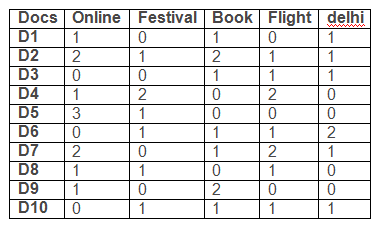It is the process of grouping documents such that documents in a cluster are similar and documents in different cluster are dissimilar. Vector space model is used.
Algorithm
- Choose the value of k
- K objects are randomly chosen to form centroid of k clusters
- Repeat until no change in location of centroid or no change in objects assigned to cluster
Find distance of each object to cluster center and assign it to one with minimum
Calculate mean of each cluster group to compute new cluster centers
Let k=3 an initial cluster seeds be d2, d5 and d7.
calculating Euclidean distance between d1 and d2 :
The clusters are:
d2, d1, d6, d9, d10
d5, d8
d7, d3, d4
If you want something and you get something else, never be afraid. One day things will surely work your way!!
Google AIY Vision Kit
Google has introduced the AIY Voice Kit back in May, and now the company has launched the AIY Vision Kit that has on-device neural network acceleration for Raspberry Pi. Unlike the Voice Kit, the Vision Kit is designed to run the all the machine learning locally on the device rather than talk to the cloud. While it was possible to run TensorFlow locally on the Raspberry Pi with the Voice Kit, the previous kit was far more suited to using Google’s Assistant API or their Cloud Speech API to do voice recognition. However the Vision Kit is designed from the ground up to run do all its image processing locally. The Vision kit includes a new circuit board, and computer vision software can be paired with Raspberry Pi computer and camera.
In addition to the Vision, users will need a Raspberry Pi Zero W, a Raspberry Pi Camera, an SD card and a power supply, that must be purchased separately. The Kit includes cardboard outer shell, the VisionBonnet circuit board, an RGB arcade-style button, a piezo speaker, a macro/wide lens kit, a tripod mounting nut and other connecting components.
The main component of the Vision Kit is the VisionBonnet that features the Intel Movidius MA2450 which is a low-power vision processing unit capable of running neural network models on-device. The software includes three models:
- Model to recognize common objects
- Model to recognize faces and their expressions
- Person, cat and dog detector
Google has also included a tool to compile models for Vision Kit, and users can train their own models with Google’s TensorFlow machine learning software. The AIY Vision kit costs $44.99 and will ship from December 31st through Micro Center. This first batch is a limited run of just 2,000 units and is available in the US only.
AWS Deeplens
Amazon’s Deeplens device introduced at Amazon ReInvent is aimed, at software developers and data scientists using machine learning, and Amazon have packed a lot of power into it a 4 megapixel camera that can capture 1080P video, a 2D microphone array, and even an Intel Atom processor. Intended to sit connected to the mains and be used as a platform, as a tool. It’s a finished product, with a $250 price. It will be shipped only after April 2018. DeepLens uses Intel-optimized deep learning software tools and libraries (including the Intel Compute Library for Deep Neural Networks, Intel clDNN) to run real-time computer vision models directly on the device for reduced cost and real-time responsiveness. It supports major machine learning frameworks like Google’s TensorFlow, Facebook’s Caffe2, Pytorch, and Apache MXNET. DeepLens will be tightly integrated with other cloud and AI services sold by AWS.
The Amazon kit is aimed at developers looking to build and train deep learning models in the real world. The Google kit is aimed at makers looking to build projects, or even products. The introduction of TensorflowLite and the Google AIY Vision kit can be regarded as a recent trend in moving the computation to the device rather than the cloud.
Reference:
https://aiyprojects.withgoogle.com/
https://aws.amazon.com/deeplens/
https://aws.amazon.com/blogs/aws/deeplens/
Adopting the right attitude can convert a negative stress into a positive one

